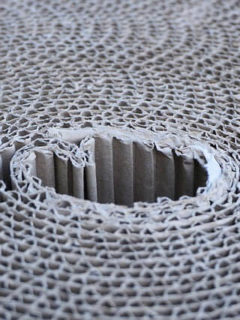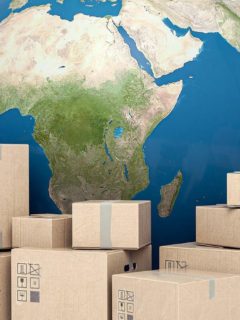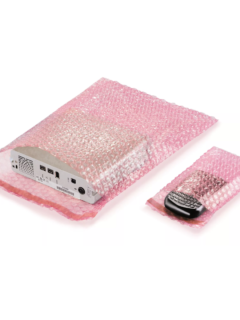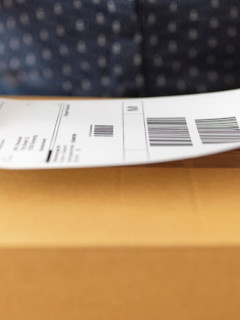Cardboard packaging should be robust. The quality and strength of the cardboard and cardboard from which they are made determines whether the contents are properly protected at any point (during transport, in the warehouse and in the sorting plant). Before it is put into general use, it must be properly tested from various angles, including strength. What are the most important tests to which cardboard boxes are subjected?
Corrugated cardboard – the most popular type of cardboard packaging material
Corrugated cardboard packaging is distinguished by its particular durability and strength. When choosing your packaging material, you should mainly pay attention to the grammage (density) of the material and the type of waves. The higher the grammage and the more layers, the better. The standard grammage of corrugated cardboard is 315 g/m3. It is worth remembering that a higher cardboard grammage also means a higher packaging weight.
As for the wave, this is how the space between the layers of cardboard is referred to. There are several basic types of wave. 3-ply cartons consist of E-waves (approximately 1.5 mm thick), B-waves (approximately 3 mm thick) and C-waves (approximately 4 mm thick). 4-ply cartons have EE or EF waves (about 2.5 mm thick). The much heavier 5-layer cartons consist of EB wave (approximately 4.5 mm thick) and BC wave (approximately 6.5 mm thick).
Each wave gives the carton packaging different properties. Thicker waves mean that the boxes are more resistant to mechanical damage, but also heavier. A thinner wave, on the other hand, provides greater flexibility, ease of handling and lightness – such a carton can be easily folded, for example.
Some packages made of a thicker wave (e.g. 5-layer, 7-layer) can be described as non-standard shipments – packages for special tasks.
Solid cardboard – an alternative to corrugated cardboard
Corrugated cardboard is the thinner equivalent of corrugated cardboard. It resembles thicker paper in appearance. It differs from corrugated cardboard in that it has a smoother surface with virtually no waves. Packaging made from solid cardboard is lightweight and delicate. They are used in the cosmetic, confectionery and pharmaceutical industries (e.g. to create packaging for medicines, cosmetics and cakes). Boxes made of solid cardboard are less strong and therefore will not be suitable for storing and transporting heavy, valuable items.
Compressive strength – the most important test for the strength of cardboard boxes
The compression strength (BCT, Box Compression Test) is measured very simply. The cardboard packaging (just the finished, moulded box) that is about to be tested is placed between two compression plates. The person performing the BCT then deliberately increases the pressure of the plates – until a wave deformation occurs that causes a loss of strength. The test is performed with the plates in different positions: previous, longitudinally, vertically. The BCT makes it possible to determine what maximum pressure the finished box can withstand, as well as the optimum number of layers in which the boxes with contents can be stored.
The BCT test can also be described as a method for optimising packaging costs. An optimal cardboard box is one whose required strength is achieved at the lowest possible cost.
Flat crush resistance
The Flat Crush Test (FCT) is a test that mainly concerns 3-ply and 5-ply cardboard. The material is placed on a press and pressure is applied until the corrugated layer breaks. The conclusion is: the more force that has to be applied to bend the cardboard, the more resistant the cardboard packaging will be to impact, punctures. The results from the FCT are given in kPa (kiloPascals).
Edge crush resistance
Edge Crush Resistance (ECT, Edgewise Crush Test) is another test that measures the strength of the carton. It looks as follows: The cardboard packaging is placed between boards, which exert pressure until the cardboard breaks. This test is particularly useful for packaging that is later stored and stacked. ECT results are reported in kN/m (kiloNewtons per metre).
Puncturing and perforation
Puncturing is one of the most frequent causes of damage to cardboard packaging, which is why it is important that its strength is also tested in this respect. This test is performed using a pyramid with a right-angled triangle in the base. The puncture resistance of a carton is measured in J (joules).
Puncturing significantly affects the security of the shipment. This property relates to the strength of the corrugated board to a force acting perpendicular to its surface, such as pressure (exerted from the inside as well as by external forces). The buckling test examines the maximum resistance of a single sheet of paper or board to pressure acting perpendicular to its surface. Buckling resistance is, in other words, the application of uniformly increasing pressure to one side of the surface of the specimen and the determination of the value at which this specimen breaks. The results of this test are given in kPa.
The higher the resistance to bursting shown by the cardboard, the lower the possibility of damage to the box and the items packed in it.
Moisture absorption resistance test – Cobb method
In the water absorption resistance test, the degree of moisture in the cardboard packaging is tested. A sample of the material (cardboard) is immersed in water for a defined period of time (it must be weighed accurately beforehand). After removal from the water, it is weighed again. The resulting increase in weight is used to determine the level of absorption. This increase determines how much water 1 m2 of cardboard can absorb in a given time. Pay particular attention to how quickly the cardboard box absorbs a large amount of water – if it does so quickly, it will definitely not be suitable for use in adverse weather conditions. Such a cardboard box can become damp (both inside and out) and – as a result – the contents will be destroyed.
Experts say that with a 1% increase in moisture content, corrugated cardboard can lose up to 10% of its strength.
The best cardboard boxes for packaging – only at RAJA
If you are looking for good quality, environmentally friendly parcels for shipping, you will find them at RAJA. For starters, get to know our bestsellers among packaging cartons.
It goes without saying that the most popular types are flap cartons and cut cartons. However, that is not all. Customers also often choose cartons with automatic bottoms. Such boxes are ordered to save storage space. When folded up, these boxes take up very little space and are assembled quickly and without problems. They save time for the warehouse staff who do the packing.
Less popular, but just as cost-effective, are height-adjustable cartons. For the shipment of books, on the other hand, so-called wrappers – special book boxes with height-adjustable scales and self-adhesive closures – are commonly used.
Whatever your choice of carton, there is one thing everyone should learn – find out the 4 effective steps for packing parcels for shipping.
It is worth remembering that cardboard packaging at RAJA consists of 3-ply, 5-ply and, somewhat less commonly, 7-ply cardboard. The first two types are particularly popular.














